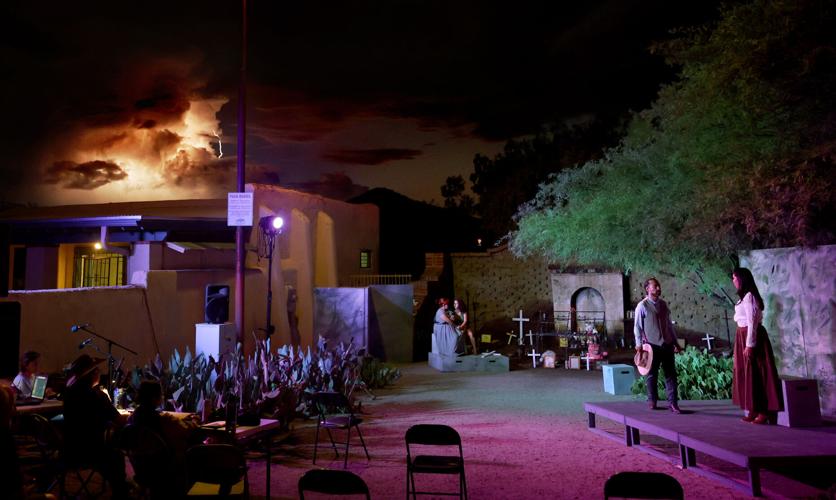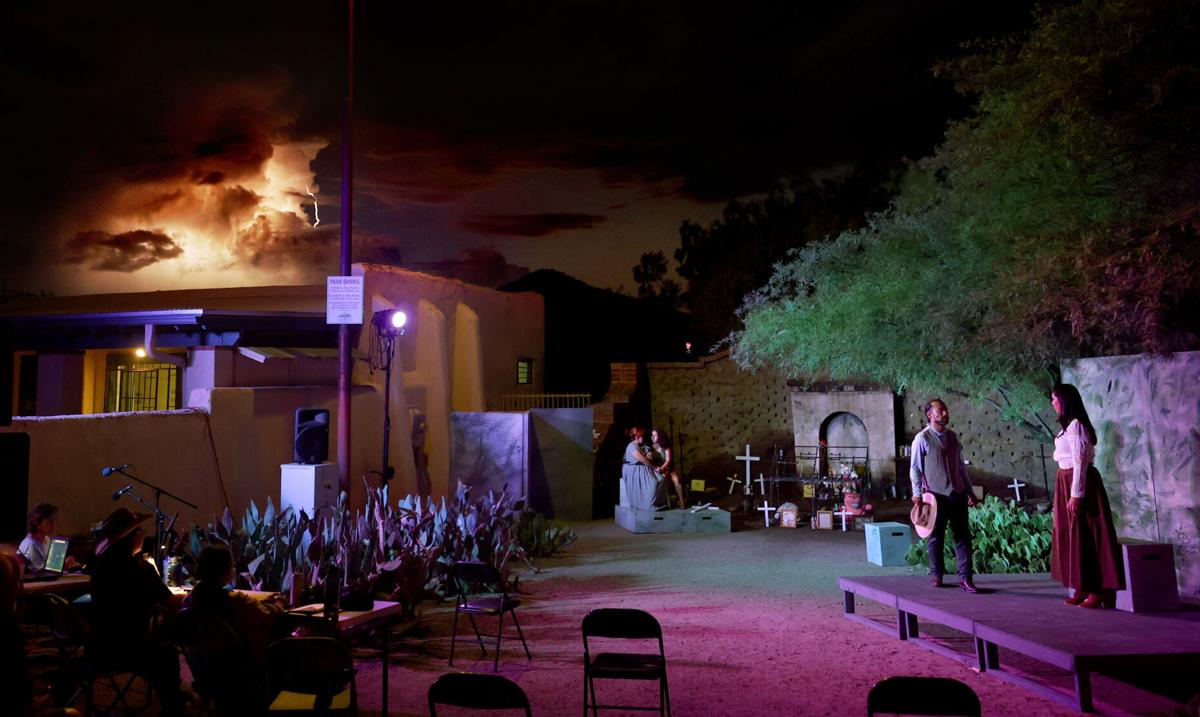A new immersive play honoring migrants who have died in the desert surrounding Tucson, and documenting the activism keeping their memory alive, premiers this week at a legendary site in Tucson’s Barrio Libre: El Tiradito, known as the “Wishing Shrine.”
The play, titled “El Tiradito,” will be held nighty from Thursday to Saturday of this week, and again from Sept. 21-24, starting at 7:30 p.m.
Three overlapping storylines intersect in the play by Elaine Romero, an award-winning playwright and associate professor in the University of Arizona’s School of Theater, Film & Television.
One plot line explores the mythology of the original El Tiradito, a man named Juan Oliveras whom legend has it was murdered by his lover’s husband in 1871. Another storyline focuses on an activist confronted with a harsh reality, and the third centers on a traveler through the Sonoran Desert who leaves something behind.
“Those three stories, in my mind, all fuse together in the play,” Romero said in an interview this week. “We begin to see that they’re not separate.”
The work is intended to move audiences to get involved in human rights activism.
“That’s always the hope: that our art inspires action, that it doesn’t end at the applause,” Romero said.
The play’s set location at the shrine in downtown Tucson was chosen intentionally: El Tiradito, listed on the National Register of Historic Places in the 1970s, has became a quasi-religious site in Tucson, where generations of children and adults have lit candles and made wishes at the alleged scene of an adulterer’s murder.
The shrine has also long been home to ceremonies that honor the thousands of migrants who have perished trying to cross the Sonoran Desert, said Alba Jaramillo, play organizer, activist and actress.

Actress Alba Jaramillo runs onto the stage, El Tiradito shrine, while rehearsing for the upcoming play’s performances.
For decades, members of the Coalición de Derechos Humanos have gathered at the Wishing Shrine to read and record the names of migrants who lost their lives on their journey, and to honor the more than 1,500 unknown migrants, or “desconocidos,” whose remains have not been identified, Jaramillo said.
The shrine’s vitality and sacredness is tangible, she said.
“It’s a place for miracles, according to our community (folklore). But it’s also a place that is very important to activists for solidarity,” said Jaramillo, co-executive director of the Immigration Law and Justice Network and founder of theater company Teatro Dignidad.
The play “El Tiradito” is a collaboration between Teatro Dignidad, the Coalición for Derechos Humans and the University of Arizona Confluence Center for Creative Inquiry’s “Fronteridades” program, which aims to create a more inclusive and accurate portrayal of border communities.
The play’s immersive component means the audience will be engaged in the shrine’s desert-like setting, as actors move around them, and attendees will have some opportunity to participate in the performance, Jaramillo said.
A personal tragedy
Jaramillo says the plight of migrants is personal to her: A native of Agua Prieta, Sonora, Jaramillo grew up undocumented in Tucson. Her family is now mourning her Mexican-born cousin, who last year attempted to cross the U.S.-Mexico border and was never heard from again, after his last cell phone contact outside Yuma, she said.
In August alone, the remains of 25 people were found in the Sonoran Desert, according to Tucson nonprofit Humane Borders. Eight of the deceased had been dead for less than a day when their remains were found.
Since 2001, Humane Borders has catalogued and mapped more than 4,100 migrants’ remains, in partnership with the Pima County Office of the Medical Examiner. Many more will likely never be recovered, advocates say.
The play makes a direct connection between the ongoing tragedy and the immigration policies that Jaramillo says make these migrant deaths inevitable: the U.S.’s long-running policy of “prevention through deterrence” — a militarized border that ends up channeling migrants to dangerous, remote areas of the desert — combined with the degradation of the asylum system, she said.
Out of thousands in need, only about 40 people a day in Nogales, Sonora are able to get an appointment with an asylum officer through the new CBP One app, created by the Biden administration, she said.
The outcome is predictable, Jaramillo said: When legitimate routes to safety are inaccessible, those who fear for their lives will do whatever necessary to survive.
Romero added, “There’s this impression that it’s the migrants who are creating the crisis, when it’s the policies that are creating the crisis. I think our play articulates that.”
Sacred site
Many versions of the legend of El Tiradito — “the castaway” — are in circulation. The most well-known tells of Juan Oliveras, a sheepherder of Mexican descent who in the 1870s became infatuated with his mother-in-law. The lovers were caught in bed by her husband, Oliveras’ father-in-law, who subsequently murdered Oliveras with an ax.
The bloodied site of Oliveras’ death became a wishing shrine organically, as many held to the traditional belief that “certain dead could grant wishes if votive candles were lit to them in prayer and supplication,” according to the 1971 form nominating El Tiradito for recognition on the National Register of Historic Places.

Rachel Pazos, left, Taylor Hernandez and Alba Jaramilllo rehearsing for the upcoming performances of "El Tiradito" at the shrine of the same name.
The successful effort to list the site on the National Register was spearheaded by University of Arizona folklorist Byrd Howell Granger, who aimed to protect the site from the city’s plans to build a road through it.
The mythology has been kept alive for 140 years by visitors to this “shrine of the unconsecrated,” a folklore that’s rich in inspiration for a writer, Romero said.
“I’m very interested as a writer in the imperfections of human beings, even those of us who do activism or who try to hold up the highest ideals in our lives,” she said.
The shrine also represents a unique confluence of Mexican and American culture that transcends borders, according to its National Register nomination form.
The shrine “is a unique reminder to Tucson and to the state of their Spanish and Mexican heritage. El Tiradito is a cultural manifestation which has been supported by the Spanish-speaking community for a hundred years,” the 1971 form reads. “There is none other like it in the state of Arizona. ... It represents our regional heritage and folklore of the greater Southwest.”
This binational history makes the shrine an ideal place for audiences to reflect on the unity and timelessness of the Sonoran Desert, artificially divided by a man-made line, Romero said.
“We are one,” she said, “and I hope this play helps all of us to feel that in our bones.”
Get your morning recap of today's local news and read the full stories here: tucne.ws/morning







